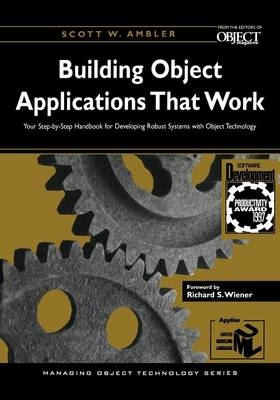
Building Object Applications that Work
Cambridge University Press (Verlag)
978-0-521-64826-4 (ISBN)
Written by internationally acclaimed trainer and developer Scott Ambler, this book is a must-have resource for designers, programmers and testers of today's OO applications. The author takes you through the entire process of building object applications, from analyzing the project (so you know what you need to build), to designing a user-friendly interface, to testing your approaches to make sure your applications work properly. Building Object Applications That Work includes sections on: • how to use the Unified Modeling Language effectively • analysis, so you know what you need to build • design techniques, so that you know how you are going to build your application • collecting the right metrics to improve your development approach • applying OO patterns to improve the quality of your applications • creating applications for stand-alone, client/server and distributed environments • using both relational and object-oriented databases to make your objects persistent • architecting your applications so they are maintainable and extensible.
Part I. Introduction to Building Object Applications: 1. Where we've been before - object-oriented concepts and techniques; Part II. Object-Oriented Analysis Design, and Architecture: 2. Bubbles and lines - useful diagrams for object-oriented analysis and design; 3. Improving your design - a class-type architecture; 4. Reusing your development efforts - object-oriented patterns; 5. Development in the 90s and beyond - designing distributed object-oriented applications; Part III. Object-Oriented Construction: 6. Measuring and improving the quality of your work - object-oriented metrics; 7. Choosing an object-oriented language - comparing the leading languages; 8. Building your application - effective object-oriented construction techniques; 9. Making your application usable - object-oriented user interface design; 10. Making your objects persistent - object-orientation and databases; 11. Integrating legacy code - wrapping; Part IV. Object-oriented Testing: 12. Making sure your applications work - full life-cycle object-oriented testing (FLOOT); Part V. Conclusion: 13. Where to go from here - personal success strategies; Appendix A. Notation summary; Appendix B. Visual glossary.
| Erscheint lt. Verlag | 13.2.1998 |
|---|---|
| Reihe/Serie | SIGS: Managing Object Technology |
| Verlagsort | Cambridge |
| Sprache | englisch |
| Maße | 178 x 254 mm |
| Gewicht | 870 g |
| Themenwelt | Informatik ► Software Entwicklung ► Objektorientierung |
| ISBN-10 | 0-521-64826-2 / 0521648262 |
| ISBN-13 | 978-0-521-64826-4 / 9780521648264 |
| Zustand | Neuware |
| Haben Sie eine Frage zum Produkt? |
aus dem Bereich


